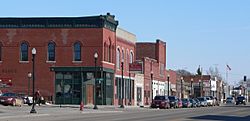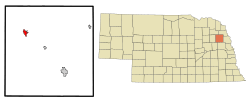Wisner, Nebraska facts for kids
Quick facts for kids
Wisner, Nebraska
|
|
|---|---|

Downtown Wisner: northeast side of Avenue E (US 275), March 2010
|
|

Location of Wisner, Nebraska
|
|
| Country | United States |
| State | Nebraska |
| County | Cuming |
| Area | |
| • Total | 1.28 sq mi (3.31 km2) |
| • Land | 1.25 sq mi (3.24 km2) |
| • Water | 0.03 sq mi (0.07 km2) |
| Elevation | 1,411 ft (430 m) |
| Population
(2020)
|
|
| • Total | 1,239 |
| • Density | 990.41/sq mi (382.55/km2) |
| Time zone | UTC-6 (Central (CST)) |
| • Summer (DST) | UTC-5 (CDT) |
| ZIP code |
68791
|
| Area code(s) | 402 |
| FIPS code | 31-53450 |
| GNIS feature ID | 838335 |
| Website | ci.wisner.ne.us |
Wisner is a city in the state of Nebraska, United States. It is located in the northwestern part of Cuming County. In 2020, about 1,239 people lived there.
Contents
History of Wisner
Wisner was first planned out in 1871. This happened just before the railroad tracks reached the area. The city was named after Samuel P. Wisner, who worked for the Sioux City and Pacific Railroad.
The railroad service, run by the Chicago and North Western Transportation Company, stopped in 1982. This was because fewer goods were being shipped by train. Also, floods had damaged many parts of the track. The tracks were removed a few years later.
Geography of Wisner
Wisner is a city with a total area of about 1.06 square miles (2.75 square kilometers). Most of this area, about 1.03 square miles (2.67 square kilometers), is land. A small part, about 0.03 square miles (0.08 square kilometers), is water.
Population in Wisner
| Historical population | |||
|---|---|---|---|
| Census | Pop. | %± | |
| 1880 | 282 | — | |
| 1890 | 610 | 116.3% | |
| 1900 | 963 | 57.9% | |
| 1910 | 1,081 | 12.3% | |
| 1920 | 1,210 | 11.9% | |
| 1930 | 1,327 | 9.7% | |
| 1940 | 1,256 | −5.4% | |
| 1950 | 1,233 | −1.8% | |
| 1960 | 1,192 | −3.3% | |
| 1970 | 1,315 | 10.3% | |
| 1980 | 1,335 | 1.5% | |
| 1990 | 1,253 | −6.1% | |
| 2000 | 1,270 | 1.4% | |
| 2010 | 1,170 | −7.9% | |
| 2020 | 1,239 | 5.9% | |
| U.S. Decennial Census | |||
In 2010, about 1,170 people lived in Wisner. There were 506 households, which are groups of people living together. Most of the people living in Wisner were White.
The average age of people in the city was 44.6 years old. About 22% of the residents were under 18 years old. About 24% were 65 years or older.
Wisner's Livestock Industry
Wisner is well-known as a major center for livestock in Nebraska. The main economic activities in the area are farming, especially raising cattle and hogs.
At any given time, about 130,000 cattle are being fed in Wisner. This happens across more than 15 different feedlots. Louis Dinklage, a very important person in commercial cattle feeding, started his business in Wisner. He also helped fund many public places in the city.
Louis Dinklage and Dinklage Co.
Louis Dinklage was recognized in the Cattle Feeders Hall of Fame in 2013. He is seen as one of the first people to start large-scale cattle feeding businesses.
He began his work with only 25 to 30 cattle. By 1923, he had grown his operation to 400 cattle. His first goal was to feed 1,000 cattle. By the late 1930s, he was feeding about 3,000 to 4,000 cattle. He did this using simple tools like a shovel and horses.
By the 1960s, Dinklage had 65,000 cattle. This made him the largest private cattle feeder in the United States. Louis Dinklage helped and taught many other top cattle feeders in Nebraska. He was also key in starting Dinklage Feedyards.
Herman Dinklage, Inc. and the Tornado
In 2014, Wisner and nearby areas were hit by a strong tornado. This tornado was part of the 2014 Pilger, Nebraska tornado family. Herman Dinklage, Inc., a farming company, was completely destroyed. Jeff and David Dinklage, who owned the company, were fourth-generation farmers. Their family had farmed on that land for almost 100 years.
The tornado destroyed their barn, farm equipment, and home. Sadly, nearly 300 cattle were also killed.
Wisner Landmarks
Dinklage Park
This park was first called "City Park." The railroad donated the land to the city. It was next to the old Wisner high school. The park had a large gazebo and was often used for school events.
In 1960, a swimming pool was built there. This pool was replaced in 1982 with a new, heated, Olympic-sized pool. This new pool was built thanks to donations from Louis Dinklage, a local cattleman. The park was then renamed in honor of Louis and his wife, Abby Faye.
Dutch Hollow
Dutch Hollow used to be a wooded valley at the bottom of Nye Hill. It became one of the first areas settled in Wisner. Many of the oldest houses in the city can still be found here. Ninth Street in Wisner follows the old path of Dutch Hollow. Residents still call this street "Dutch Hollow."
Elkhorn River
Wisner is located right next to the Elkhorn River. This river is a branch of the Platte River. The river has caused some big events, like major floods in 1966 and 1994.
Because the river flows in a southeast direction, many of Wisner's roads also run at an angle. Very few roads in Wisner go truly north, south, east, or west. In June 2010, floodwaters washed away the road leading to the bridge. This made travel and business difficult for a while.
Kane's Lake
Kane's Lake is a lake located just south of the Elkhorn River. The area's original name, "Lakeview," came from this lake.
Land of Nod
This was an amusement park that existed from 1917 to 1940. It was located just north of today's River Park. Andy Peterson, a Wisner businessman, founded it. The park had barns for livestock shows, a dance hall, and an ice skating rink. It was also the site of Wisner's first baseball field.
The Land of Nod was a big project but it eventually closed. This was partly because the nearby City Park was developed. Today, only the park's brick entrance pillars and Peterson's old home are still standing.
Nye Hill
A large part of Wisner was built on Nye Hill. The hill was named after a veterinarian who built his home right on it. He also owned most of the land around it. His home and the barn he used for his work are still there today.
River Park
Also known as "Community Park," this park is located right by the Elkhorn River. The city of Wisner bought the land for the park in 1927.
Over the years, River Park has been used for many community events. These include baseball games, high school football games (from 1933 to 1968), and even snowmobile and motocross races. More recently, two fields for softball and youth baseball have been added. These softball fields have been used by the Wisner-Pilger High School softball team since 2007. The park also has a rodeo arena and show barns for livestock events. It has hosted many concerts and other community activities.
Rock Creek
Rock Creek is the main stream that flows into the Elkhorn River in this area. It is located south of Wisner. In the late 1800s, a group of German farmers lived near Rock Creek. They felt left out by other communities like Wisner.
These farmers formed a baseball team called the "Rock Creek Tigers." This team became very famous throughout Nebraska and Iowa. They were known for attracting large crowds to their games. The "Rock Creek Tigers" played until 1952. After that, it became too expensive to keep the team going. The remaining players then joined teams in Wisner and West Point, Nebraska.
West Field
West Field was a pasture owned by the West family. Wisner High School played its first football games here until 1930. Today, the Wisner Auditorium, community tennis courts, and the Wisner volunteer fire department are all located on this land.
"The Blacktop"
"The Blacktop" is a two-lane road paved with asphalt that goes south from Wisner. It crosses the Elkhorn River. The road was paved in 1964. At that time, the new Elkhorn River Bridge made it the only way to get into Wisner from the south.
Its official name is "6th Road," named in 1995. However, people living south of Wisner, including those in the Rock Creek community, still call it "The Blacktop." This is a common nickname for asphalt roads in the region. The road connects U.S. Highway 275 to Nebraska Highway 32. This makes it a well-known shortcut for travelers going to Lincoln, Nebraska.
U.S. Route 275
This road, known as "Highway 275," goes directly through Wisner. It forms Wisner's main street and business area. There have been ongoing talks about moving Highway 275 to routes north of town. This would be part of a project to create a four-lane expressway. Local businesses hope that some of the highway traffic will still pass through Wisner.
Notable People
- Warren Alfson – A football player who was an All-American for the Nebraska Cornhuskers in 1940. He also played in the NFL for the Brooklyn Dodgers (NFL) in 1941.
- Lewis H. Brown – A quarterback for the Nebraska Cornhuskers football team in 1930-31.
- Dale M. Hansen – He received the Medal of Honor. A U.S. Marine Corps base in Japan, Camp Hansen, is named after him.
- Virginia Huston – A Hollywood actress who appeared in the film Out of the Past.
- Jim Kane – A well-known high school sports coach.
- John Henry Kyl – He served as a Congressional Representative for Iowa.
- Jerry LaNoue – A football player who was an All-Big Six halfback for the Nebraska Cornhuskers in 1936.
- Frank Merriam – He used to be the school superintendent in Wisner. He later became the Governor of California.
See also
 In Spanish: Wisner (Nebraska) para niños
In Spanish: Wisner (Nebraska) para niños



